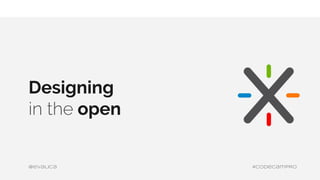Designing in the open
Talk at Codecamp Iasi 6 Apr 2019, see https://codecamp.ro/iasi#agenda Abstract: What does it mean to design in the open, what opportunities there are and how is this different from 'normal' design. When I mention the word 'design', I refer to User Experience, Interaction Design, Accessibility, Usability and User Research. I am an open source designer for more than 10 years and I've worked with multiple open source communities. Designing in the open is very different from designing for a client. Even if every community has its particular rules, we can attempt to generalize the process, but still it is very unstable, blurry and with lots of unknowns: who is the target of your product, who takes the final decision in open source, how do you evaluate your prototypes when you can't meet the people that will use the product or when you need to address users with very different backgrounds. Closed and paid products are money driven and can be very specific, but open source projects have different motors and the developers and designers need to adapt to these constraints. There are many topics to be discusses related to Open Source Design, but I will try to give an overview of the process and introduce people that never experienced Open Source Design to the concept.

Recommended
More Related Content
Similar to Designing in the open
Similar to Designing in the open (20)
More from Ecaterina Moraru (Valica)
More from Ecaterina Moraru (Valica) (20)
Recently uploaded
Recently uploaded (20)
Designing in the open
- 2. (*) fsfe.org — opensource.org — gnu.org What is Open Source? 2 / 30
- 3. (*) fsfe.org What is Open Source? 3 / 30
- 4. Can you make money with Open Source? YES, but money are not the main engine / purpose of Open Source (OS) (*) ictworks.org 4 / 30
- 5. (*) https://blog.mozilla.org/opendesign/designing-in-the-open/ What is Open Design? 5 / 30 The design type where the process and deliverables are published, in the open, and anyone can comment, study and improve, freely.
- 6. Open vs. Closed Design 6 / 30 Open Design Closed Design Process Public Participation NDA between parties Deliverables Available, Reusable Proprietary, Confidential Target Users Stakeholders
- 7. Open Design is not limited to Open Source projects But it’s easier for OS projects to adopt Open Design processes 7 / 30
- 8. Community pushing for Open Design practices in Open Source communities 8 / 30 Open Source Design (*) opensourcedesign.net
- 9. Open Source Design participants... 9 / 30
- 10. Open Design @ XWiki Over 950 proposals at http://design.xwiki.org 10 / 30
- 15. to Mockups & Prototypes 15 / 30
- 18. 18 / 10 #1 Myth: My ideas will be stolen
- 19. 19 / 30 Remote & a/synchronous communication
- 21. Feedback & Critique 21 / 30 request it often and also on unfinished work
- 22. 22 / 10 #2: It’s hard to be a perfectionist in OSD
- 23. Multiple Iterations (+ unique challenges) 23 / 30
- 25. Increase Time for decision making “The amount of discussion is inversely proportional to the complexity of the topic” Parkinson's law of triviality (1957) 25 / 30
- 26. 26 / 10 #3: “Given enough eyeballs, all bugs are shallow” Linus's Law (1999)
- 27. Open Design Benefits 27 / 30 ● Gather feedback about the design direction ● Communicate design decisions ● Gain potential solutions, resources, tips, and techniques from community ● Become accountable to an involved community ● Have impact by inspiring and teaching others ● Establish yourselves as leaders and innovators (*) http://bradfrost.com/blog/post/designing-in-the-open/
- 28. (*) http://bradfrost.com/blog/post/designing-in-the-open/ Open Design Challenges 28 / 30 ● It’s uncomfortable to share work in progress ● Dealing with the feedback ● “Other people will take our stuff” ● Extra time needed
- 30. 30 / 10 QUESTIONS? Sli.do #OSD Thank you! Questions? @evalica #CodecampRO
- 31. Want more? See similar talks ● Designers Can Open Source by Garth Braithwaite ● Remotely Open: Design Without Borders by Pedro Moreira da Silva
